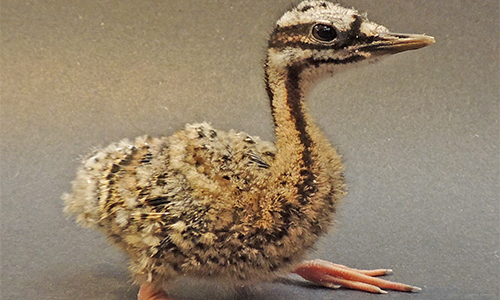Sunbittern chick hatches at Franklin Park Zoo
Wednesday October 14, 2015
The staff at Franklin Park Zoo is pleased to announce the successful hatching of a sunbittern chick.
The chick, hatched on September 19, is the first successful hatch and rearing at Franklin Park Zoo since 1995. The chick, which currently weighs 2.6 ounces, is being reared by its mother within the Bird’s World building.
“We have been monitoring the chick, as well as the parents’ behaviors, very closely and are very encouraged thus far,” said Frederick Beall, Zoo New England General Curator. “This is a significant hatch as the parents are the top ranked birds genetically within the North American captive managed population.”
While the mother is rearing the chick, zookeepers have been weighing the chick daily as well as looking for other health indicators. While both parents typically rear the chicks, the staff decided to separate the male after observing behavior that could have been harmful to the chick. The female is an attentive mother and the chick has been doing well.
In the wild, sunbitterns have a wide range and can be found throughout Central and South America near forested streams, where they primarily feed on insects and aquatic invertebrates. Although sunbitterns are not listed as a threatened or endangered species, their numbers are declining due to habitat loss. These birds, which can measure up to 24 inches in length, have long legs and slender heron-like necks with a long bill. Sunbitterns have red eyes, dark heads with white stripes, and an intricate design of brown plumage on their backs. When these birds unfold their tails and spread their wings, a spectacular pattern of rich chestnut and orange plumage is displayed.
Within the Bird’s World building, the sunbitterns can be seen in the Swamp exhibit. Because the mother is rearing the chick in the nest, it is difficult for visitors to see the chick. Once the chick is more visible, updates will be made here on our website and on our social media channels (Facebook, Twitter and Instagram).
Photos: Zoo New England/Sarah Woodruff







